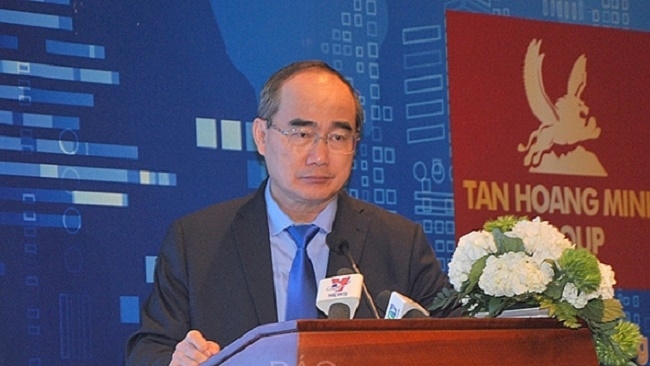Vietnam turns semiconductor vision into action
The global semiconductor industry is being reshaped by geopolitical tensions, shifting supply chains, and the surge of digital technologies.




The uncertainty of the economy in the changing trends, the impacts of the US-China trade war and the infrastructure in need of upgrading are the main challenges that Vietnam has to face in 2019.

At the 48th Chief Financial Officer (CFO) World Congress held in Ho Chi Minh City on November 15th, regarding the biggest risks to Vietnam’s economy in 2019, PhD. Han Manh Tien, Chairman of Vietnam Association of Corporate Directors (VACD), stated, "The biggest risk is the legal regulations of Vietnam."
"Besides, out of 600,000 operating Vietnamese enterprises, nearly 98 per cent are small and medium enterprises (SMEs). We must have a specific regulatory framework for SMEs in the Industry 4.0," he said.
According to Teng Theng Dar, Founder of Asia Entrepreneurs Exchage, in the future, Vietnam could be seen as a safe destination for investors.
With the CPTPP agreement signed with 11 economies, at least there are more opportunities to expand new markets in the Pacific.
He said that the biggest challenge for Vietnam now was to move to a new supply chain.
"To do so, we should invest in the infrastructure. The macro infrastructure is the weakness of Vietnam. In a world full of changes, Vietnam should become one of the most stable investment environments as soon as possible," he said.
Meanwhile, VinaCapital & RMIT Professor Ian Alexxander Eddie emphasised that the current economic capacity of Vietnam mainly came from the FDI sector. To minimise the impacts of the US-China trade war, it was necessary to reinforce the internal strength of Vietnamese enterprises.
"We need to focus more on the market of more than 90 million people in Vietnam and 600 million people in ASEAN to develop our labour skills, hence taking opportunities in the region before going any further," he said.
Regarding Vietnam's labour force quality, the International Association of Financial Executives Institutes (IAFEI) President Fausto Cosi stated, "I was surprised to learn that Vietnam spends 5.7 per cent of the state budget on education. This is an essential need, as nearly 40 per cent of Vietnamese people are under 25. We can take this opportunity to improve the labour force quality."

In the 48th CFO World Congress, Secretary of the Ho Chi Minh City Party Committee Nguyen Thien Nhan gave a detailed talk on the achievements, growth dynamics, weaknesses, solutions and vision of 2030 of Vietnam’s economy.
According to him, Vietnam has seven major economic driving forces. Among them, institutional reform is the most important for the impressive growth in recent years of the Vietnamese economy.
Secondly, Vietnam is a country with the stable political and social status. Currently, Vietnam is the strategic partner of more than 15 countries, including Russia, China, Thailand, Italy and South Korea as well as the comprehensive partner of 10 other countries including Australia, the USA, Ukraine, and Denmark.
Besides, Vietnam’s labour market had one million workers more every year, which would last until 2035. It was forecasted that by 2020 there would be 43.8 million trained workers, which took up 70.2 per cent of Vietnam’s labour force. The abundant supply of labour at the average training level makes labour costs in Vietnam relatively low, only about $1 per hour in 2012.
However, according to Nhan, apart from those dynamics, Vietnam had three weaknesses, which, if failed to be timely repaired, could drag the economy behind in the region.
The first weakness is low labour productivity. The reason was insufficient investment in technology of the business - production process. From 2001 to 2011, on average, 59.6 per cent of Vietnamese enterprises still used backward technology. The supply and value chains of many Vietnamese businesses were distorted as they only focused on production but neglected the design, branding, promoting or distribution system building activities.
The second weakness is the ailing infrastructure. The last one is the negative impacts of climate change on coastal provinces.
To overcome these three weaknesses, Nhan proposed seven solutions. "In all, the application of the most advanced technology inproduction-service-management to increase productivity is still the vital solution," Nhan emphasised.
The global semiconductor industry is being reshaped by geopolitical tensions, shifting supply chains, and the surge of digital technologies.
The change in APA approval authority is expected to shorten processing time and enhance business proactiveness in international tax negotiations.
As hybrid cloud systems grow more complex, Vietnamese enterprises are struggling to detect cybersecurity threats moving laterally within their own networks.
The submission of the draft resolution on Vietnam’s international financial center to the National Assembly heralds a new developmental era for the country.
More than just running a 5-star resort, Kristian Petersen is redefining the art of hospitality with a humane and sustainable leadership philosophy.
For Tyna Huynh, co-founder of Drinkizz, organic is not just a food choice but a way of life that fosters a deep connection between people, nature and community.